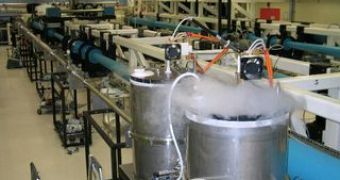Last year, an Italian collaboration sparked the interest of physicists all around the world when they announced that they have observed the conversion of a photon particle, into a predicted axion particle, thus discovering the first particle outside the Standard Model and the first observation of dark matter. A team of scientists from France has recently shown in a paper issue of Physical Review Letters that the experiment was invalid, due to an optical measurement failure.
The Italian team and the Polarizzazione del Vuoto con LASer have designed last year an optical experiment to detect the optical non-linearity of quantum vacuum, in which they have observed unpredicted behavior. They found that by using a magnetic field it was possible to rotate the polarization plane of light polarized linearly in vacuum. Though the effect is commonly known, it was never observed in a vacuum.
To find an explanation for the phenomenon, the team at PVLAS suggested that photon particles decayed into axion particles through a process known as the Primakoff effect. After upgrading the apparatus, the team reported in 2007 that they retract the original claim and the observations were due to instrument errors, since the rotation of the polarization plane was no longer being detected.
The strong-CP presents an unsolved problem in particle physics for more than three decades, so to explain the interactions physicists predicted the appearance of a particle with small mass that had a neutral electric charge, part of the bosons class with zero spin, but it was never detected. Currently several experiments are being built in Germany, Switzerland and the U.S. in the hope that the particle will be observed, thus resolving the strong-CP problem.
The most popular experiment regarding the detection of axion particles involves a photoregeneration technique. The interactions of photon particles with a magnetic field will hopefully convert the light-carrying particle into an axion. The stream of particles is fired at a 15-mm wide aluminum wall, which is opaque to light, but not to axion particles. As the particles exist on the other side of the wall, the magnetic field will trigger it to convert back into photons which will be detected.
However the detection of the photon particles proves to be problematic since perfect light shielding is needed. To overcome this problem scientists use pulsed laser and magnetic fields, synchronized together to determine a single photon detector to measure extremely small conversion rates. By using the optimized detection technique and other optimized variables, the French team reported that the photon regeneration of the other side of the wall was not detected, and furthermore, the calculations made regarding the conversion model totally exclude the possibility of detection.
Nevertheless, the experiments which are being built at this moment are expected to detect the particle in the future, thus solving two of the problems of current physics. The strong-CP and the possibility of existing dark matter which is believed to have a proportion of about 25 percent of the universe might explain the extra gravitational pull which is being observed.

 14 DAY TRIAL //
14 DAY TRIAL //